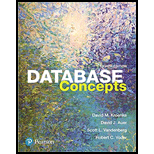
Explanation of Solution
Determinant in following relation:
Assumption 1:
PetName → (PetType, PetBreed, PetDOB, OwnerLastName, OwnerFirstName, OwnerPhone, OwnerEmail)
In the above expression, PetName attribute determines PetType, PetBreed, PetDOB, OwnerLastName, OwnerFirstName, OwnerPhone, and OwnerEmail attributes, left term “PetName” refers the determinant, and “→” defines the relationship.
- That is, the PetType, PetBreed, PetDOB, OwnerLastName, OwnerFirstName, OwnerPhone, and OwnerEmail are functionally dependent on PetName.
Therefore, the “PetName” is the determinant for this assumption.
Assumption 2:
OwnerEmail → (OwnerLastName, OwnerFirstName, OwnerPhone)
In the above expression, OwnerEmail attribute determines OwnerLastName, OwnerFirstName, and OwnerPhone attributes, left term “OwnerEmail” refers the determinant, and “→” defines the relationship.
- That is, the OwnerLastName, OwnerFirstName, and OwnerPhone are functionally dependent on OwnerEmail.
Therefore, the “OwnerEmail” is the determinant for this assumption.
Assumption 3:
OwnerPhone → (OwnerLastName, OwnerFirstName, OwnerEmail)
In the above expression, OwnerPhone attribute determines OwnerLastName, OwnerFirstName, and OwnerEmail attributes, “OwnerPhone” refers the determinant, and “→” defines the relationship.
- That is, the OwnerLastName, OwnerFirstName, and OwnerEmail are functionally dependent on OwnerPhone...
Want to see the full answer?
Check out a sample textbook solution
Chapter 2 Solutions
DATABASE CONCEPTS+MYITLAB
 Principles of Information Systems (MindTap Course...Computer ScienceISBN:9781285867168Author:Ralph Stair, George ReynoldsPublisher:Cengage Learning
Principles of Information Systems (MindTap Course...Computer ScienceISBN:9781285867168Author:Ralph Stair, George ReynoldsPublisher:Cengage Learning Database Systems: Design, Implementation, & Manag...Computer ScienceISBN:9781305627482Author:Carlos Coronel, Steven MorrisPublisher:Cengage Learning
Database Systems: Design, Implementation, & Manag...Computer ScienceISBN:9781305627482Author:Carlos Coronel, Steven MorrisPublisher:Cengage Learning Database Systems: Design, Implementation, & Manag...Computer ScienceISBN:9781285196145Author:Steven, Steven Morris, Carlos Coronel, Carlos, Coronel, Carlos; Morris, Carlos Coronel and Steven Morris, Carlos Coronel; Steven Morris, Steven Morris; Carlos CoronelPublisher:Cengage Learning
Database Systems: Design, Implementation, & Manag...Computer ScienceISBN:9781285196145Author:Steven, Steven Morris, Carlos Coronel, Carlos, Coronel, Carlos; Morris, Carlos Coronel and Steven Morris, Carlos Coronel; Steven Morris, Steven Morris; Carlos CoronelPublisher:Cengage Learning Principles of Information Systems (MindTap Course...Computer ScienceISBN:9781305971776Author:Ralph Stair, George ReynoldsPublisher:Cengage Learning
Principles of Information Systems (MindTap Course...Computer ScienceISBN:9781305971776Author:Ralph Stair, George ReynoldsPublisher:Cengage Learning
 Fundamentals of Information SystemsComputer ScienceISBN:9781337097536Author:Ralph Stair, George ReynoldsPublisher:Cengage Learning
Fundamentals of Information SystemsComputer ScienceISBN:9781337097536Author:Ralph Stair, George ReynoldsPublisher:Cengage Learning





